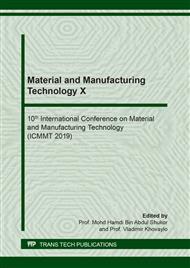[1]
Meher Abhinav, E., Chandrasekaran, G. & Kasmir Raja, S. V. Appl. Surf. Sci. 418 (2017) 308.
Google Scholar
[2]
Mortazavi, B., Dianat, A., Cuniberti, G. & Rabczuk, T. Electrochim. Acta 213 (2016) 865.
Google Scholar
[3]
Rupp, C. J., Chakraborty, S., Anversa, J., Baierle, R. J. & Ahuja, R. ACS Appl. Mater. Interfaces 8 (2016) 1536.
Google Scholar
[4]
Gupta, S. K., Singh, D., Rajput, K. & Sonvane, Y. RSC Adv. 6 (2016) 102264.
Google Scholar
[5]
Monshi, M. M., Aghaei, S. M. & Calizo, I. Surf. Sci. 665 (2017) 96.
Google Scholar
[6]
Zhu, L., Chang, X., He, D., Xue, Q. & Li, X. Nanotechnology 28 (2017) 135703.
Google Scholar
[7]
Ye, M. et al. Phys. E Low-Dimensional Syst. Nanostructures 59 (2014) 60.
Google Scholar
[8]
Balendhran, S., Walia, S., Nili, H., Sriram, S. & Bhaskaran, M. Small 11 (2015) 640.
DOI: 10.1002/smll.201402041
Google Scholar
[9]
Xiao, P., Fan, X. L. & Liu, L. M. Comput. Mater. Sci. 92 (2014) 244.
Google Scholar
[10]
Ma, Y., Dai, Y., Niu, C. & Huang, B. J. Mater. Chem. 22 (2012) 12587.
Google Scholar
[11]
Si, C. et al. Phys. Rev. B - Condens. Matter Mater. Phys. 89 (2014) 115429.
Google Scholar
[12]
Kaloni, T. P., Schreckenbach, G., Freund, M. S. & Schwingenschlogl, U. Phys. Status Solidi - Rapid Res. Lett. 10 (2016) 133.
Google Scholar
[13]
Pang, Q., Li, L., Zhang, C.-L., Wei, X.-M. & Song, Y.-L. Mater. Chem. Phys. 160 (2015) 96.
Google Scholar
[14]
Pang, Q. et al. Appl. Surf. Sci. 314 (2014) 15.
Google Scholar
[15]
Nagarajan, V. & Chandiramouli, R. Superlattices Microstruct. 101 (2017) 160.
Google Scholar
[16]
Xia, W., Hu, W., Li, Z. & Yang, J. Phys Chem Chem Phys 16 (2014) 22495.
Google Scholar
[17]
Zhang, R. et al. Phys. Chem. Chem. Phys. 18 (2016) 12169.
Google Scholar
[18]
Chen, X. et al. J. Mater. Chem. C 4 (2016) 5434.
Google Scholar
[19]
Bayani, A. H., Dideban, D. & Moezi, N. Superlattices Microstruct. 100 (2016) 198.
Google Scholar
[20]
Yan, J.-A., Gao, S.-P., Stein, R. & Coard, G. Phys. Rev. B 91 (2015) 245403.
Google Scholar
[21]
Dhar, N., Bandyopadhyay, A. & Jana, D. Curr. Appl. Phys. 17 (2017) 573.
Google Scholar
[22]
Gonze, X. et al. Comput. Mater. Sci. 25 (2002) 478.
Google Scholar
[23]
Martin Fuchs, M. S. Computer Physics Communications 119 (1999) 67.
Google Scholar
[24]
Perdew, J. P., Kieron, B. & Ernzerhof, M. Phys. Rev. Lett. 77 (1996) 3865.
Google Scholar
[25]
Pack, J. D. & Monkhorst, H. J. Phys. Rev. B 13 (1976) 5188.
Google Scholar
[26]
Li, X., Wu, S., Zhou, S. & Zhu, Z. Nanoscale Res. Lett. 9 (2014) 110.
Google Scholar
[27]
Li, S. et al. Phys. Chem. Chem. Phys. 16 (2014) 15968.
Google Scholar
[28]
Lebègue, S. & Eriksson, O. Phys. Rev. B 79 (2009) 115409.
Google Scholar
[29]
Houssa, M. et al. Appl. Phys. Lett. 98 (2011) 223107.
Google Scholar
[30]
Trivedi, S., Srivastava, A. & Kurchania, R. J. Comput. Theor. Nanosci. 11 (2014) 781.
Google Scholar


